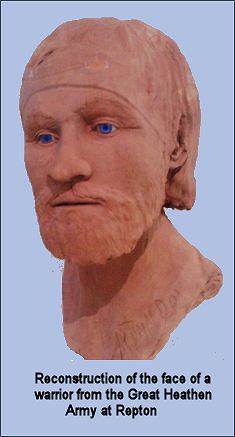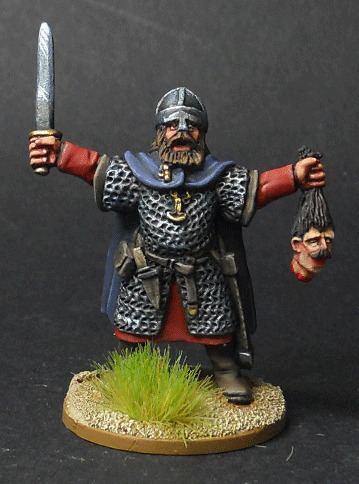Reign 876–877 Predecessor Eystein Olafsson Siblings Ivar the Boneless Reign 875–877 Parents Ragnar Lodbrok | Successor Guthfrith Name Halfdan Ragnarsson Predecessor None Successor Barid | |
 | ||
Died 877 AD, Strangford Lough, United Kingdom Grandparents Sigurd Hring, Alfhild Gandolfsdatter Great-grandparents Gandalf Alfgeirsson, Gauthild Gyrithe Alfsdottir Similar People | ||
Halfdan Ragnarsson (Old Norse: Hálfdan; Old English: Halfdene or Healfdene; Old Irish: Albann; died 877) was a Viking leader and a commander of the Great Heathen Army which invaded the Anglo-Saxon kingdoms of England, starting in 865. According to the tradition recorded in the Norse sagas he was one of the sons of Ragnar Lodbrok, and his brothers included Björn Ironside, Ivar the Boneless, Sigurd Snake-in-the-Eye and Ubba. He was the first Viking King of Northumbria and a pretender to the throne of Kingdom of Dublin. He died at the Battle of Strangford Lough in 877 trying to press his Irish claim.
Contents

Biography
Halfdan was one of the leaders of the Great Heathen Army which invaded the Anglo-Saxon kingdom of East Anglia in 865. According to the Norse sagas this invasion was organised by the sons of Ragnar Lodbrok, of whom Halfdan was one, to wreak revenge against Ælla of Northumbria. Ælla had supposedly had Ragnar executed in 865 by throwing him in a snake pit, but the historicity of this explanation is unknown. The invaders are usually identified as Danes, although the tenth-century churchman Asser stated that the invaders came "de Danubia", which translates as "from the Danube"; the fact that the Danube is located in what was known in Latin as Dacia suggests that Asser actually intended Dania, a Latin term for Denmark.

In the autumn of 865 the Great Heathen Army landed in East Anglia, where they remained over the winter and secured horses for their later efforts. The following year the army headed north and invaded Northumbria, which was in the midst of a civil war between Ælla and Osberht, opposing claimants for the Northumbrian throne. Late in 866 the army conquered the rich Northumbrian settlement of York. The following year Ælla and Osberht put their differences aside, and teamed up to retake the town. The attempt was a disaster, and both of them lost their lives. With no obvious leader, Northumbrian resistance was crushed and the Danes installed a puppet-king, Ecgberht, to rule in their name and collect taxes for their army.

Later in the year the Army moved south and invaded the kingdom of Mercia, capturing the town of Nottingham, where they spent the winter. The Mercian king, Burghred, responded by allying with the West Saxon king Æthelred, and with a combined force they laid siege to the town. The Anglo-Saxons were unable to recapture the city, but a truce was agreed whereby the Danes would withdraw to York, where they remained for over a year, gathering strength for further assaults.

The Danes returned to East Anglia in 869, this time intent on conquest. They seized Thetford, with the intention of remaining there over winter, but they were confronted by an East Anglian army. The East Anglian army was defeated and their king, Edmund, was slain. Medieval tradition identifies Edmund as a martyr who refused the Danes' demand to renounce Christ, and was killed for his steadfast Christianity. Ivar and Ubba are identified as the commanders of the Danes, and the killers of Edmund, and it is unknown what part, if any, Halfdan took.

Following the conquest of East Anglia Ivar apparently left the Great Heathen Army – his name disappears from English records after 870. However, he is generally considered to be identical to Ímar, a Norse King of Dublin who died in 873. With Ivar in Ireland, Halfdan became the main commander of the Army, and in 870 he led it in an invasion of Wessex. Sometime after Ivar left the Army, a great number of Viking warriors arrived from Scandinavia, as part of the Great Summer Army, led by Bagsecg, bolstering the ranks of Halfdan's army. According to the Anglo-Saxon Chronicle, the Danes battled the West Saxons nine times, including the Battle of Ashdown on 8 January 871. However, the West Saxons could not be defeated, and Halfdan accepted a truce from Alfred, newly crowned king of Wessex.

The Army retreated to the captured town of London and stayed there over the winter of 871/872. Coins minted in London during this period bear the name Halfdan, identifying him as the leader of the army. In autumn of 872 the Army returned to Northumbria to quell a revolt against Ecgberht, their puppet-king. However, this explanation for the army's move north has been challenged, and it has been suggested the relocation was a result of a war with Mercia. In any case, the Army overwintered at Torksey, and then at Repton a year later. The Army finally conquered Mercia in 874, and their king, Burghred, was deposed and replaced by a puppet, Ceolwulf.
Following this victory the Army split in two – one half under Guthrum heading south to continue fighting against Wessex, and one half under Halfdan heading north to fight against the Picts and Britons of Strathclyde. According to the Annals of Ulster, Eystein Olafsson, King of Dublin was "deceitfully" killed in 875 by "Albann", a figure generally agreed to be Halfdan. His brother Ivar had ruled the city prior to his death in 873 and it appears Halfdan's campaigning was an attempt to regain his brother's lost kingdom. Regardless, Halfdan did not remain in Ireland: in 876 he and his forces returned to Northumbria, and settled an area largely coextensive with the old kingdom of Deira, with the northern part of Northumbria remaining under Anglo-Saxon rule. Sources sometimes title Halfdan King of Jórvík, beginning in 876.
It seems that Halfdan's rule of Dublin was not secure, and he was deposed while away in York. Halfdan returned to Ireland in 877 to try to recapture the city, but he was met with an army of "Fair Heathens" – a contentious term usually considered to mean the Viking population who had been in Ireland the longest, as opposed to the newly arrived "Dark Heathens", of whom Halfdan was one. The forces met at the Battle of Strangford Lough and Halfdan was slain. Those of Halfdan's men who survived the battle returned to Northumbria via Scotland, fighting a battle along the way in which Constantine I, King of the Picts was killed. It seems the Vikings of Northumbria were content to remain kingless until 883, when Guthfrith was made king.
Some believe that Halfdan and Hvitserk (a son of Ragnar Lothbrok) are actually the same person
Historicity
Halfdan and his brothers are considered historical figures, although opinion regarding his supposed father is divided. According to Hilda Ellis Davidson, writing in 1979, "certain scholars in recent years have come to accept at least part of Ragnar's story as based on historical fact". Katherine Holman, on the other hand, concludes that "although his sons are historical figures, there is no evidence that Ragnar himself ever lived, and he seems to be an amalgam of several different historical figures and pure literary invention."
